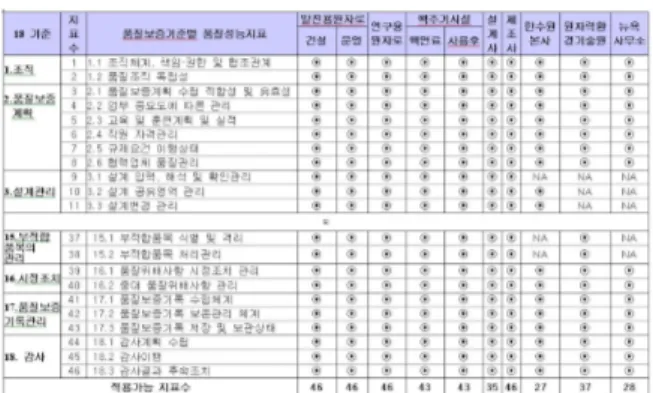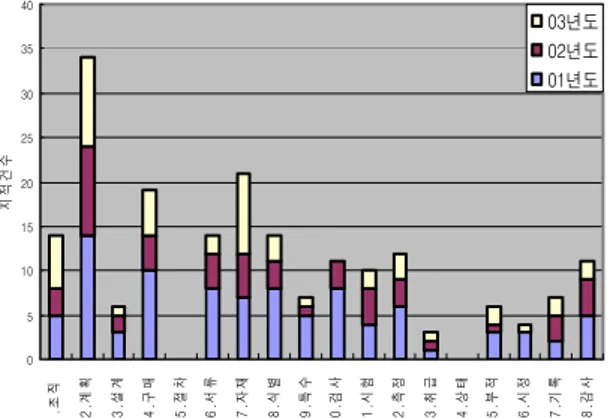A development of Trend Analysis System on
Quality Assurance Inspection Results
K.M.Oh, G.S.Choi, S.K.Ahn, W.H.Lee,
Korea Institute of Nuclear Safety, 19, GUSUNG-DONG YUSONG-GU, TAEJON
Ⅰ. Introduction
The purpose of periodic quality assurance (QA) inspection by KINS is to confirm the adequacy of QA program and the effectiveness of its implementation in accordance with a licensee’s quality assurance program previously approved.
In actual, KINS has performed regulatory QA inspection since March 13th, 1996 entrusted by the MOST. This inspection is executed for major nuclear related enterprises according to Enforcement Decree of the Act Article 31. Inspections typically are performed at a frequency of once every one or two years or three years according to KINS’s internal guideline. This regulatory inspection covers siting, design, fabrication, installation, operation, and decommissioning activities of nuclear related facilities. Up to now, inspection findings and recommendations were issued and accumulated approximately to one thousand. But, the trends of a licensee’s quality assurance program performance were not systematically analyzed yet. Therefore, this study introduces quality performance indicator and trend analysis system in order to effectively assess a licensee’s quality assurance program performance. Using this trend analysis system, the trends of QA inspection findings and recommendations are quantitatively analyzed, based on finding cause codes.
II. Survey on assessment method of quality assurance program performance
Effectiveness of and trends in quality assurance program performance is periodically evaluated by regulatory body in order to ensure that a licensee’s QA program is satisfactorily complying with the QA program requirements and the QA program is effective in providing adequate confidence in safety of nuclear related facilities [1]. This provides performance element of quality assurance program for the stages of the licensing process such as siting, design, manufacture, construction, commissioning, operation, and decommissioning.
NRC established a method for the overall evaluation of a transportation packaging vendor’s compliance with regulatory requirements and QA program commitments in performance elements [2]. The performance elements are assessed considering inspection findings derived and their
consequences. The performance colors code (Green, Yellow, Red, Blue) are assigned into each element that indicates the level of performance.
Nuclear procurement issues committee (NUPIC) reports trends of quality assurance program performance of suppliers based on finding cause codes. This report also analyzes quality assurance program elements that suppliers are continuing to have problems implementing [3].
The NRC standard review plan also provides quality assurance criteria derived from performance-based QA requirements [4].
The finding is normally classified by two categories such as significant condition and trivial condition, based on its importance, complexity, and so on [5, 6, 7].
III. Development of quality performance indicator and finding cause code
The quality performance indicator and finding cause code were developed through the above survey on assessment method of quality assurance program performance. The quality performance indicator was derived from the analysis of QA related regulation, standard and associated documents. Finding cause codes were improved and categorized into 5 groups. The survey results are summarized below.
1) Development of quality performance indicator
- Derivation of QA performance elements (# 46) through 18 QA criteria (refer to Fig. 1)
Fig. 1 Applicability of quality performance indicator 2) Introduction of new finding cause code categories
against MOST Notice 2001-43 [8] - 18 QA criteria
- 46 QA performance elements
Transactions of the Korean Nuclear Society Autumn Meeting Busan, Korea, October 27-28, 2005
- 2 significance conditions (significant/trivial)
- 7 licensing stages(siting/design/fabrication/construction /commissioning /operation/decommissioning) - 5 reference documents(regulatory requirement/licensing
requirement/QA standard/applicable standard/licensee procedure)
IV. Application results of trend analysis system
Some application results of trend analysis system were developed using quality performance indicator and finding cause code. The several cases are introduced as follows.
Fig. 2 shows a comparison of 18 quality assurance criteria for inspection findings from 2001 to 2003. The quality assurance program criterion remains the highest trend area. Fig. 3 represents a comparison of quality performance indicator for inspection findings from 2001 to 2003. The main contributor to the problems in quality assurance program was recorded in finding cause codes related to deficiency of implementation of training program and qualification control of personnel. Fig. 4 provides overall performance results of each licensee’s quality assurance program which are derived from the combination of quantitative assessment on the implementation of quality assurance program and QA mind of management and personnel.
Fig. 2 Trend analysis of findings based on 18 quality assurance criteria
Fig. 3 Trend analysis of findings based on quality performance indicator
Fig. 4 Overall performance of a licensee’s QA program
V. Conclusions
This study proposed a method on development of the trend analysis system for the assessment of a licensee’s QA program performance in order to improve the effectiveness of regulatory QA inspection activities. It includes the development of quality performance indicator and the introduction of finding cause code categories improved to comply with the regulatory QA inspection activities.
Using periodic assessment results of trends of a licensee’s QA program performance, deficient areas of a licensee’s QA program performance can easily be evaluated and regulatory resources will be focused on degradation or problems in the area of concern. In addition, it can be utilized in adjusting the inspection frequency and scope of the particular quality assurance criteria or performance elements in order to make better use of its available inspection manpower.
References
[1] NUREG/CR-6314, Quality Assurance Inspections for Shipping and Storage Containers
[2] IAEA Technical Reports No. 296, Regulatory Inspection of the Implementation of Quality Assurance Program [3] NUPIC (Nuclear Procurement Issues Committee) Trend Report, 2001
[4] NUREG-0800, Standard Review Plan, 17.3 Quality Assurance Program Descriptions (QAPD)
[5] KEPIC QAP-1, Nuclear Quality Assurance, 2000 [6] IAEA Safety Standard 50-C/SG-Q2, Corrective action and non-conformance, 1996
[7] International standard, ISO 9001 Quality Management System, 1994
[8] MOST Notice 2001-43, Regulation on Disposition and Management of Inspection Findings from Nuclear Facilities 0 2 4 6 8 10 12 절차부적합 품질보증계획수립 적합성 및 유효성 미흡 업무 중요도에 따 른 관리 미흡 교육 및 훈련계획 및 실적미흡 직원 자격관리 미 흡 절차 미준수 2.1 2.2 2.3 2.4 2.5 2.6 2. 품질보증계획 - 부적합분류코드 지적 수 2003년도 2002년도 2001년도 0 5 10 15 20 25 30 35 40 1 .조직 2.계 획 3. 설 계 4. 구 매 5. 절 차 6. 서 류 7. 자 재 8. 식 별 9. 특 수 10 .검 사 11 .시 험 12 .측 정 13 .취 급 14 .상 태 15 .부 적 16 .시 정 17 .기 록 18 .감 사 지적건수 03년도 02년도 01년도

